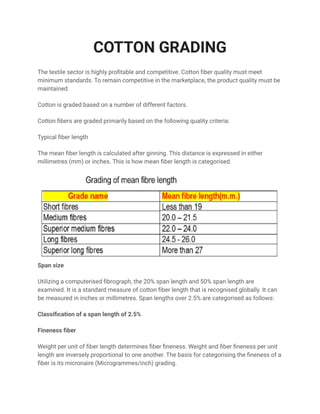COTTON GRADING For Yarn.pdf
•
0 likes•88 views
The textile sector is highly profitable and competitive. Cotton fibre quality must meet minimum standards. To remain competitive in the marketplace, the product quality must be maintained. Cotton is graded based on a number of different factors.
Report
Share
Report
Share
Download to read offline

Recommended
Recommended
More Related Content
Similar to COTTON GRADING For Yarn.pdf
Similar to COTTON GRADING For Yarn.pdf (20)
Textile studies part 2 by Rajesh Sharma, Chandigarh, India 

Textile studies part 2 by Rajesh Sharma, Chandigarh, India
Recently uploaded
Recently uploaded (16)
Pitch Presentation for Service Design in Technology

Pitch Presentation for Service Design in Technology
Redefining Globalization, urbanisation and Localisation

Redefining Globalization, urbanisation and Localisation
FW25-26 Fashion Key Items Trend Book Peclers Paris

FW25-26 Fashion Key Items Trend Book Peclers Paris
The Design Code Google Developer Student Club.pptx

The Design Code Google Developer Student Club.pptx
Extended Reality(XR) Development in immersive design

Extended Reality(XR) Development in immersive design
Art Nouveau Movement Presentation for Art History.

Art Nouveau Movement Presentation for Art History.
COTTON GRADING For Yarn.pdf
- 1. COTTON GRADING The textile sector is highly profitable and competitive. Cotton fiber quality must meet minimum standards. To remain competitive in the marketplace, the product quality must be maintained. Cotton is graded based on a number of different factors. Cotton fibers are graded primarily based on the following quality criteria: Typical fiber length The mean fiber length is calculated after ginning. This distance is expressed in either millimetres (mm) or inches. This is how mean fiber length is categorised. Span size Utilizing a computerised fibrograph, the 20% span length and 50% span length are examined. It is a standard measure of cotton fiber length that is recognised globally. It can be measured in inches or millimetres. Span lengths over 2.5% are categorised as follows: Classification of a span length of 2.5% Fineness fiber Weight per unit of fiber length determines fiber fineness. Weight and fiber fineness per unit length are inversely proportional to one another. The basis for categorising the fineness of a fiber is its micronaire (Microgrammes/inch) grading.
- 2. fiber tenacity fiber maturity-coefficient The maturity of the fiber is influenced by cotton development. Compound microscopes are used to determine the maturity of fiber. 100 to 200 fibers are placed on a slide and moistened with an 18% caustic soda solution to calculate the maturity co-efficient. The maturity co-efficient is categorised as follows:
- 3. x Uniformity Ratio This trait indicates the consistency of cotton fiber length. The ratio of 2.5% span length to 50% span length, presented as a percentage, is the uniformity ratio of cotton fiber. Following is a classification of uniformity ratio: Colour appearance of cotton Classification of cotton colour is based on the yellow colour present in cotton. In India according to colour cotton is classified as follows:
- 4. • White • Gray • Pearly